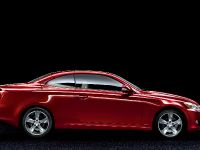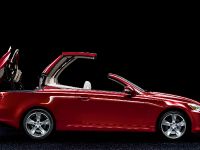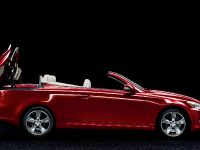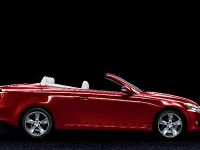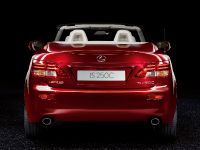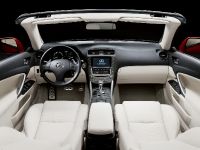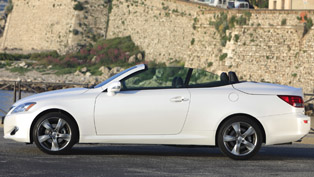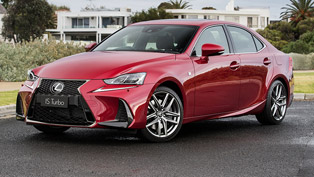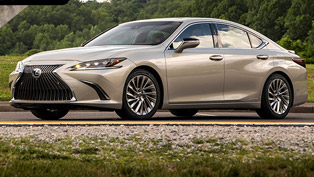Lexus IS 250C
The new Lexus IS 250C, which will go on sale this summer, combines the sharp styling of the IS saloon range with open-top engineering ingenuity. The result is top-down driving pleasure with uncompromised dynamic performance.
True to Lexus's legendary quality and attention detail, the new IS 250C has been engineered to achieve excellent aerodynamics, torsional rigidity, NVH levels and safety performance in both coupe and convertible configurations.
The lightweight roof structure can be opened or closed in just 20 seconds, the fastest time for any three-part folding roof system on the market. And thanks to the compact packaging of the folding mechanism, it takes up minimal space in the boot, giving the car class-leading load space, generous rear seat access and spacious rear passenger accommodation.
The IS 250C shares its 204bhp (208 DIN hp) 2.5-litre V6 engine and six-speed automatic transmission with the IS 250 saloon. It is styled to minimise wind turbulence when driving with the roof stowed, while extensive revisions to the body structure and suspension provide a high level of torsional rigidity. This ensures ride comfort and, when the car is in coupe guise, class-leading NVH performance. Where safety is concerned, Lexus has engineered and equipped the car to achieve a top five-star rating in independent Euro NCAP crash testing.
The IS 250C is the third model in the IS Range, joining the petrol and diesel IS saloons and the ultra-high performance IS-F.
Exterior Design The IS 250C builds on the L-finesse design characteristics of the IS saloon, with elegant proportions, sweeping lines and contrasting convex and concave surfacing. In spite of its close relationship to the saloon, it only shares a handful of common body elements: bonnet, headlamps, door handles and door mirrors. All other body panels have been redesigned to harmonise with the convertible's folding roof.
The front overhang has been increased by 15mm to improve aerodynamic efficiency when driving with the top down. There is also a new fog lamp design, integrated in the deep front air dam. In profile the IS 250C is characterised by muscular coachwork below a pronounced, rising beltline that kicks up towards the rear. The steeply raked windscreen flows seamlessly in the aerodynamic arc of the roofline, while the crisp C-pillar is integrated into the folding roof structure.
In coupe guise, the cabin tapers towards the rear, giving a fluid transition from the roofline through the C-pillar to the luggage compartment.
At the rear there are new combination light clusters with distinctive linear LED illumination, and a high-mounted LED stop light built into the upper lip of the boot lid.With the hard top stowed the IS 250C's elegant profile is punctuated only by the roll-over hoops behind the rear headrests. None of the roof mechanism elements remain in view or project above the car's waistline, reinforcing the sweep of the beltline; the entire roof system is concealed beneath the boot surface and the flush-fitting rear parcel shelf.
Interior Design and Comfort The IS 250C shares the saloon's high levels of interior luxury and practical innovation, with a number of bespoke technical revisions to ensure the on-board comfort and entertainment systems work effectively when driving in convertible mode.
The low profile front sports seats are heated and ventilated and have a new arched frame with an integral seatbelt guide. Extra comfort for top-down driving is provided by additional heating pads at shoulder height, increased heater capacity and greater ventilation airflow.
The two full-size rear seats are set 30mm further inboard than those of the IS saloon to optimise headroom and are separated by a centre console with integrated cupholders. Ample legroom is provided thanks to the more slender profile of the front seats and a class-leading 542mm between the rear H-point to the front seatback.
Access to the rear seats is made easier by an increase of 300mm in the length of the front doors, compared to the saloon. The front seats have a one-touch walk-in button which automatically folds and slides the seat forwards.
Generous luggage space has been achieved by lengthening the rear overhang by 50mm and exceptionally compact packaging of the folding roof structure. With the hard top in place capacity is 583 litres; with the roof down it is 235 litres. The IS 250C is the only car in its class to be able to accommodate a nine-inch golf bag with the hard top stowed and the luggage cover in place.
The instrument panel and surrounding interior components are the same as on the IS saloon. However, the instrument binnacle has been extensively revised to ensure visibility in open-top driving. The dial colour has been changed, LED contrast increased and the transmissivity of the glass reduced from 30 to 20 per cent. The shape of the needles has been changed and the dials themselves gain metal-tone bezels, and the central multi-display screen adds a hard-top operation status indicator. The scrupulous attention to detail extends to the rear view mirror, which has a shorter, strengthened mount to minimise shake.
The climate control system has been configured for top-down motoring with the addition of a speed sensitive control that automatically increases air flow in roof-down mode, further increasing the flow according to vehicle speed.
The LCD touch screen controls for the audio and navigation systems have been improved with a redesigned set-up screen and extra tabs for the audio functions. Both the standard eight-speaker 246W premium sound system and the 12-speaker 365W Mark Levinson Surround System gain equaliser tuning to provide consistent audio quality whether the roof is up or down, automatically adapting to the loss of bass when the roof is stowed.
Both systems provide USB and audio jack plug connectivity for full control of personal music players such as iPods. Bluetooth mobile phone connectivity is also provided, with an audio/video streaming function. Using the hard disk drive (HDD) in the Lexus Navigation system, the audio unit includes a sound library facility, which uses Compact Disc Data Base technology to transfer music files up to a 10GB capacity.
The new Lexus Navigation System has a 40GB HDD capacity, making it one of the fastest and most accurate systems on the market. It covers the whole of Europe and recognises the traffic information infrastructure of each country. The voice recognition function has been upgraded, with four additional languages. The new menu can be operated in 14 languages, including Cyrillic characters.
Three-part Folding Roof The IS 250C's folding roof structure is made entirely of lightweight aluminium and has the fastest opening and closing time of any three-part roof at 20 seconds.
Developed with the benefit of the quality and attention to detail Lexus gained with its SC convertible, the folding hard top uses 15 motors and 35 sensors to achieve an unparalleled level of smooth, seamless and silent operation.
The entire headlining is trimmed in fabric for quality and acoustic comfort. Attention to detail on the seals also improves acoustic performance and ensures the roof is watertight against rain, car washes and even high-pressure cleaning jets.
The ultra-quiet operating mechanism is activated by a button on the dashboard. It has a unique "roof brake" component, which slows the closing action as the hard top approaches the top edge of the windscreen. Unlike other systems where the weight of the roof causes the closing speed to increase just before the point of closure, the IS 250C's hard top descends smoothly into place.
Because the folding operation extends the upper boot lip 250mm beyond the rear bumper, the system incorporates a clearance sonar safety system, integrated in the rear bumper. If the system detects any obstacles between 350 and 450mm from the rear bumper, it will remain operational, but will alert the driver with a proximity warning. If an obstacle is located within 350mm, the system automatically becomes inoperable, and a warning is given to the driver. All driver warnings from the clearance sonar and the operational status of the hard-top appear on the multi-display screen in the instrument binnacle.
Aerodynamics and Wind Stream Management The IS 250C has been designed to combine the lowest possible drag coefficient with minimal wind turbulence affecting the open cabin. Thanks to the steeply raked windscreen, ultra-smooth cabin profile and aerodynamically efficient duck-tail rear styling with an ‘airkick' effect in the rear lamp clusters, the coupe-convertible has a drag coefficient of 0.29, which compares favourably with the 0.27 Cd rating for the IS saloon.
Lexus engineers focused their attention on reducing wind turbulence and generating the most comfortable airflow characteristics for occupants when the roof is lowered. The angle of the windscreen and the highly detailed design of its top edge make a major contribution to the exceptionally low wind
turbulence those on board experience around the face, shoulders and thighs, even without the optional rear seat wind deflector in place.
A comprehensive array of underbody covers, combined with new under-bracing to give maximum torsional rigidity, is central to the IS 250C's aerodynamic performance. The covers include a front spoiler, an engine undercover with aerodynamic steps to promote a Venturi effect, a transmission undercover, front and rear wheel spats, full floor and fuel tank covers, a rear suspension cover and a rear floor diffuser with vertical fin and airfoil.
The Venturi effect at the front of the car, the flat middle section and the rear diffuser effect ensure a smooth and fast airflow beneath the car, reducing lift and aerodynamic drag, significantly improving high speed vehicle stability.
High Rigidity, High Strength Bodyshell The IS 250C features numerous structural changes to provide collision strength, roll-over protection and torsional rigidity, minimising cowl shake and improving chassis controllability.
Torsional rigidity is increased through extensive underfloor bracing, including front and rear V-shaped torque box braces, a front underfloor trapezoidal brace and a rear suspension brace.
Front, upper and floor level crossmembers have been incorporated and gussets joining the upper part of the B-pillar to the upper rear crossmember contain body deformation in the event of a side impact. There is also a sub-latch mounted on the trailing edge of the door impact beam, which transmits side impact energy to the lower B-pillar.
The A-pillar is made from ultra-high tensile sheet steel. The lower part of the A-pillar has a combined centre plate and boot plate structure and the lower section of the B-pillar has a plate added to suppress any surface buckling due to the height difference between the upper surface of the rocker panel and the strengthened rear floor crossmember. The rocker panel itself has a larger cross-section, 55mm taller and 29mm wider than that of the saloon, giving better torsional and flexural rigidity and collision strength.
Ride and Handling The IS 250C uses the proven front double wishbone and rear multi-link suspension design of the IS saloon, giving sporting, agile driving. However, significant chassis revisions have been made to give greater ride comfort appropriate for a convertible and ensure consistent dynamic performance in both coupe and convertible guise.
To achieve the best ride comfort, the front suspension coil springs and dampers have been fine tuned, the torsional stiffness of the suspension bushing has been reduced, and the shape of the front anti-roll bar has been adjusted. The Electronic Power Steering benefits from a bespoke gear ratio for maximum vehicle controllability and stability.
Revisions to the rear suspension include tuning of the springs and dampers for improved ride comfort, high capacity rubber mounts for reduced vibration, and reductions in the torsional rigidity of the bushes. This further improves ride comfort through smooth suspension movement with minimal alignment change. The rear toe-control arm has been redesigned, a performance ring has been added to the suspension tower, and the upper support has been lowered by 38.5mm to increase rigidity, increase luggage space in the boot and improve linear yaw response.
Noise, Vibration and Harshness The chassis and bodyshell revisions, together with extensive temperature, vibration and shaking tests, have been implemented to ensure that in coupe configuration the IS 250C demonstrates class-leading NVH characteristics.
Comprehensive underfloor bracing and the use of high tensile strength sheet steel cross-bracing promote high body structure rigidity to eliminate body and cowl shake. Fine-tuning of the front and rear suspension and revisions to the mountings reduce vibration at idle and minimise both noise transmission and vibration from the road surface. And the effective deployment of sound insulation, in particular in the rear partition, further minimises booming, road and engine noise.
Acoustic windscreen glass and optimised roof, door and window panel seals give the IS 250C class-leading low wind noise levels.
Safety The IS 250C has been designed to achieve a maximum five-star rating in both Euro and US NCAP crash testing, offering world-class safety in both coupe and convertible configuration.
Following the example of the IS saloon range, the IS 250C benefits from the highest content of active and passive safety technology in the segment, including Lexus's Vehicle Dynamics Integrated Management (VDIM). This incorporates Vehicle Stability Control (VSC) specifically tuned for an open-body car and to ensure shorter stopping distances on split-friction road surfaces; a revised Pre-Crash Safety (PCS) system; and the world's first twin-chamber passenger front airbag.
In open-top driving safety performance is further improved with a new, larger design side airbag that provides head protection in the event of a side impact. The bodyshell has also been equipped with extra energy absorbing side impact pads for front and rear seat occupants.
LEXUS IS 250C PROVISIONAL TECHNICAL SPECIFICATIONS (pending final homologation)
| ENGINE | |||
| Engine code |
4GR-FSE |
||
| Engine type |
V6, 60° |
||
| Valve mechanism |
24 valves DOHC, dual VVT-i |
||
| Block & head material |
Aluminium |
||
| Displacement (cc) |
2,500 |
||
| Bore x stroke (mm) |
83.0 x 77.0 |
||
| Fuel rating |
95 octane petrol or higher |
||
| Compression ratio |
12.0:1 |
||
| Max. power (bhp/rpm) |
204 @ 6,400 |
||
| Max. torque (Nm/rpm) |
252 @ 4,800 |
||
| PERFORMANCE | |||
| 0-62mph (sec) |
9.0 |
||
| Max. speed (mph) |
99 |
||
| DIMENSIONS | |||
| Overall length (mm) |
4,635 |
||
| Overall width (mm) |
1,800 |
||
| Overall height (mm) |
1,415 |
||
| Wheelbase (mm) |
2,730 |
||
| Track front (mm) |
1,535 |
||
| Track rear (mm) |
1,535 (17in wheel) 1,525 (18in wheel) |
||
| Overhang front (mm) |
820 |
||
| Overhang rear (mm) |
1,085 |
||
| Minimum running ground clearance (mm) |
130 |
||
| Coefficient of Drag (Cd) |
0.29 |
||
| Minimum turning radius (m) |
5.1 |
||
| Fuel tank capacity (litres) |
65 |
||
| INTERIOR DIMENSIONS | |||
| Interior length (mm) |
1,605 |
||
| Interior width (mm) |
1,480 |
||
| Interior height (mm) |
1,130 |
||
| Effective head room (mm) | Front |
973.5 |
|
| Rear |
917.5 |
||
| Effective head room (mm) | Front |
862.0 |
|
| Rear |
403.5 |
||
| Effective legroom (mm) | Front |
1,377.8 |
|
| Rear |
1,136.4 |
||
| Hip room (mm) | Front |
1,378.4 |
|
| Rear |
1,101.0 |
||
| Luggage capacity | Top up |
583 |
|
| Top down |
235 |
||
| WEIGHTS (kg) | |||
| Kerb weight - min./max. (kg) |
1,730/1,755 |
||
| Gross vehicle weight (kg) |
2,075 |
||
| TRANSMISSION | |||
| Type |
A960E (6AT) |
||
| Gear ratios | 1st |
3.538 |
|
| 2nd |
2.060 |
||
| 3rd |
1.404 |
||
| 4th |
1.000 |
||
| 5th |
0.713 |
||
| 6th |
0.582 |
||
| Reverse |
3.168 |
||
| Differential Gear Ratio |
3.909 |
||
| FUEL CONSUMPTION | |||
| Urban (mpg) |
21.6 |
||
| Extra Urban (mpg) |
35.8 |
||
| Combined (mpg) |
30.4 |
||
| EMISSIONS | |||
| CO2 (g/km) |
219 |
||
| VED band |
K |
||
| SUSPENSION | |||
| Front |
Double wishbones |
||
| Rear |
5-arm multilink |
||
| BRAKES | |||
| Front (diameter x width, mm) |
Ventilated discs, 296 x 28 |
||
| Rear (diameter x width, mm) |
Solid discs, 310 x 18 |
||
| STEERING | |||
| Type |
Rack and pinion |
||
| Ratio |
14.6 |
||
| Power steering type |
Electric Power Steering (EPS) |
||
| Turns (lock to lock) |
3.16 |
||
| TYRES AND WHEELS | |||
| Tyre size |
Front 225/40 R18 Rear 255/40 R18 |
||
